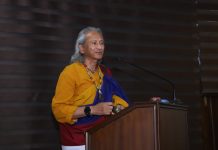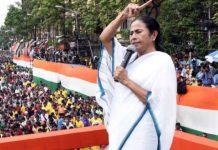The Congress plenary session, with a fiery speech of Congress President Rahul Gandhi, gave clear indications of an epic battle ahead. By likening the BJP to Kauravas and the Congress to Pandavas, Rahul sought to set the agenda for the next election. The analogy from the Mahabharata conveyed that the forthcoming general election would be like the fight between Kauravas and Pandavas. The latter were small in number but on the right side. Rahul Gandhi was aggressive, mocked at the BJP’s role in the freedom struggle, ridiculed the alleged crony capitalism and the corrupt with references from Hindu mythology and compared the BJP’s ‘arrogance’ with that of the Kauravas and called himself a Pandava.
Fierce fights ahead
This also showed that we are headed for one of the fiercest and most bitter electoral battles. Earlier when Sonia Gandhi laid table for Opposition parties’ dinner, it had all the ingredients for Congress’ revival under Rahul Gandhi when she said that the contest will be over the ‘Idea of India’ and the style of the present government. Would India make peace with the culture of fear and intimidation, vigilante mobs, and the mocking of scientific temper? She questioned much to the discomfiture of the BJP after losses in the recent by-polls. Now, Rahul Gandhi is positioning himself as the Prime Minister’s primary challenger with the support of like-minded parties. Personal attacks on Prime Minister Narendra Modi and BJP President Amit Shah make it clear that Congress will run a relentless campaign and try to put the Modi government on the defensive on various issues.
BJP’s invincibility under Modi
All said, much would depend on the outcome of the verdict in states going to the polls this year — Karnataka first and Rajasthan, Chhattisgarh and Madhya Pradesh later this year. The invincibility of the BJP has come under the scanner in the recent by-elections in Uttar Pradesh. The Congress Plenary Session took place at a time when efforts were underway to forge a third front of parties opposed to BJP as also the Congress. When Telangana Chief Minister K. Chandrasekhar Rao mooted a non-BJP and non-Congress front, he found immediate support from West Bengal Chief Minister Mamata Banerjee, but it also showed its vulnerability because it is not the coming together of all like-minded parties. Mamata’s Trinamool Congress and Rao’s Telangana Rashtra Samiti (TRS) of course have little in common, other than an antipathy to the BJP and the Congress. This leaves good space for the Congress to engage with all anti-BJP parties and for Rahul to emerge as a natural leader targeting BJP’s 2014 pith of “acche din”. So has Rahul Gandhi now truly come of age? Or is he still a prisoner of fabled Congress party’s dynastic legacy? Or an evolved politician keen to change India by involving the young in politics? The recently concluded Congress Plenary Session after his one-man show in Gujarat gave enough indications that he has been able to successfully shed the tag of an elitist leader and ‘cameo activist’.
His recent forays show that Rahul Gandhi, the president of the grand 132-year-old party, is trying to capture the imagination of the masses and possible allies. At the plenary session, he was able to define Congress’ strategy for the next general election showing need for a joint front. The new leadership’s plans to harness political creativity, connect to the digitally conscious and create greater inner party inclusivity were there for every one to see. The Congress party’s battle plans seem to be forging alliance with parties sans their ideological differences to exploit the BJP’s shrinking base of allies. The most defining moments of Rahul Gandhi’s political career came when he shed his reticence and came out of his mother Sonia Gandhi’s shadows making her observe: “He is now my boss too. Let there be no doubt about that”. It was a strategic statement to galvanize party workers to make them rally around Rahul Gandhi.
On his part at the plenary session, Rahul made a significant statement that the Congress had failed to rise to the expectations of the people and might have committed mistakes. The idea was to underline the humility of the new boss pitted against Prime Minister Modi and the BJP. The Congress made a strenuous effort to energise its workers for the electoral battles ahead at the party plenary pitching itself as the real alternative to BJP while also expressing its willingness to cooperate with like-minded parties to unseat the Modi government in the 2019 Lok Sabha elections.
To his party workers, Rahul Gandhi has promised to address their complaints that well-connected leaders often “parachute” down at the time of ticket allocation at the cost of genuine, dedicated workers. He wants to make party leaders more accessible to workers by breaking the ‘walls’ and giving more tickets to the youth. It is a fact that the Congress Party’s many state units are plagued by factionalism with leaders owing allegiances to the old order. Rahul had to indicate that he would enforce discipline so that the party’s effort at winning elections was not weakened in any way.
Another change that one could notice was that the “worker-centric” gathering was held in a different format with Rahul saying he had kept the stage empty for talented youth from within the party and outside. Only those delivering speeches went up to the stage to do so from the podium.
Forging alliances
Under Rahul Gandhi, the Congress party’s political resolution talked of adopting a pragmatic approach for cooperation with all like-minded parties and evolving a common workable programme to defeat the BJP-RSS in the next general election to reverse the BJP’s economic policies. The party’s four resolutions — political, economic, foreign affairs and on ‘agriculture, unemployment and poverty alleviation’ sought to address concerns of various sections of society. The party president, in his concluding speech, focused on youth and farmers — two sections that are perceived to be getting disenchanted with the Modi government and represent a vast section of the population.
That Rahul Gandhi is in full command was visible, as he has also started building his new team. Resignations have begun in the party. There were reports that actor-politician Raj Babbar has been asked to continue on his post till the party elects a new state unit chief.
Babbar’s case points to this nervousness in the old guard of the party after Rahul formally took over as Congress chief. Congress party’s worst performance in the recent Lok Sabha by-polls to Gorakhpur earlier represented by chief minister Yogi Adityanath and Phulpur, represented by his deputy, has reportedly irked the party president. Gujarat Congress chief Bharatsinh Solanki is also believed to have tendered his resignation to the central leadership of the party. Reports suggest that several top leaders of the party may quit in the days to come. Earlier, Goa Congress president Shantaram Naik resigned from his post, saying he was “inspired” by Rahul Gandhi’s speech at the party plenary about making way for younger leaders. Naik, 71, is the first senior Congress leader to resign after Rahul Gandhi announced in his concluding speech that he wants to give the younger generation a chance to come forward and lead the party. Naik sent his resignation to the All India Congress Committee, ending his stint as Goa Pradesh Congress Committee president since July 8, 2017, when he had replaced senior party leader Luizinho Faleiro. Naik was elected to the Lok Sabha in 1984 from North Goa constituency and twice to Rajya Sabha later. All this comes days after Rahul Gandhi was authorised to nominate the Congress Working Committee (CWC). It is learnt that the All India Congress Committee (AICC) delegates had raised their hands to unanimously authorise Gandhi to
reconstitute the CWC.
 Rahul maturing like wine
Rahul maturing like wine
The plenary session highlighted Rahul Gandhi’s coming of age and maturing like wine. His top moments in 2017-18 began with a speech at University of Berkeley. His candid admission that a “certain amount of arrogance” had crept into the Congress midway through UPA II and that the vision of the UPA government formed in 2004 had a ‘sell-by date’ of only 10 years, were trending topics. Rahul also realised the importance of social media and his social media team has made it sure that social posts from @TheOfficeofRG are noticed. His sarcasm was at its best when he introduced his followers to his dog, tweeting: “Ppl have been asking who tweets for this guy..It’s me..Pidi. I am way (cooler) than him. Look what I can do with a tweet..oops..treat!”
After “suit-boot ki sarkar” that showed he could bite with reference to the PM’s monogrammed suit, the new jingle for “Gabbar Singh Tax” referring to the Centre’s ‘flawed and hasty implementation’ of the tax regime, coined just before the Gujarat elections, made the government bring down the GST rates of 200 items and pruning the top tax slab of 28 per cent to just 50 items. He also slammed demonetisation decision at a time of agrarian distress. His single-handed election campaign and strategy of involving local leaders of other outfits forced the BJP to bring out its big guns, finding that the ground had started slipping in its fortress of 22 years. Modi, who was the state’s chief minister for 12 years, was forced to address as many as 34 election rallies in his home state. His unusual decision to visit a number of temples sent the message across that he is a “devotee of Lord Shiva”. This strategy went a long way in influencing the traditional Hindu voters of Gujarat. As a strategic move, he consciously avoided mentioning Muslims specifically during his election campaigns fully well knowing that they would any way support the Congress party. However, the deft move helped in dispelling the popular notion that the Congress works for the “appeasement of Muslims”. He has already shown glimpses of how he will run the party when veteran leader Mani Shankar Aiyar was removed from primary membership after he called PM Modi a “neech kisam ka aadmi”.
When needed, Rahul Gandhi takes on a more aggressive note and his tone becomes vitriolic when attacking the BJP for its divisive ideology and its failings on the governance front. He has contrasted the BJP’s commitment to an organisation with the Congress’s voice for the entire nation. If the economic resolution took the middle path, the political resolution was open-ended with a call for a “pragmatic approach of working with like-minded parties and evolving a common workable programme”.
 Rahul Gandhi may not be the best of speakers, he is neither fiery nor dramatic but is simple and to the point. There is lack of articulation in Rahul Gandhi and Modi has to watch out for this. Though hitting out, he loves to play as a nice humble person who is being targeted by bullies. He knows that the Congress had failed to connect with the people when BJP took over the entire social media while Congress was caught in a slumber. Congress under Rahul has become aggressive on social media, countering the BJP forcefully.
Rahul Gandhi may not be the best of speakers, he is neither fiery nor dramatic but is simple and to the point. There is lack of articulation in Rahul Gandhi and Modi has to watch out for this. Though hitting out, he loves to play as a nice humble person who is being targeted by bullies. He knows that the Congress had failed to connect with the people when BJP took over the entire social media while Congress was caught in a slumber. Congress under Rahul has become aggressive on social media, countering the BJP forcefully.
Rahul Gandhi himself is no more the “Pappu” who Modi and BJP made fun of and made the country believe he was a clown. Now, he is a totally transformed person, confident, witty and friendly. The old doubts about his leadership qualities that had been exploited by his opponents are slowly fading in the background. Ironically, the BJP had tried to hijack the Congress legacy of the freedom struggle but Rahul Gandhi has shown the zeal to fight back. He is reinventing himself and making the Congress party as a party of the future that can take on the might of the BJP in the epic battle called next general election né Mahabharata 2019!
letters@tehelka.com













